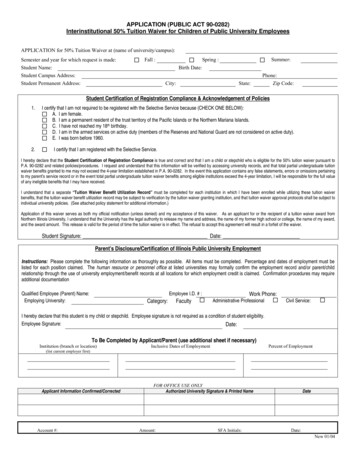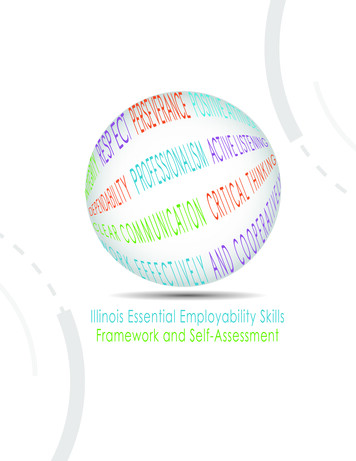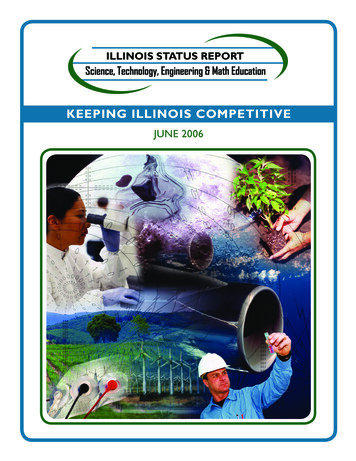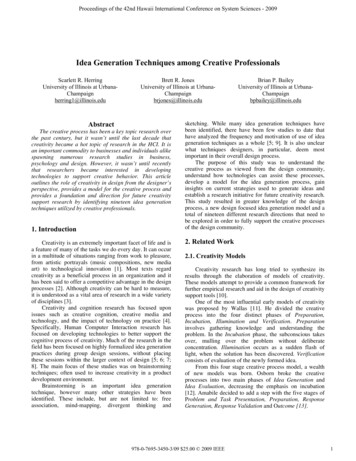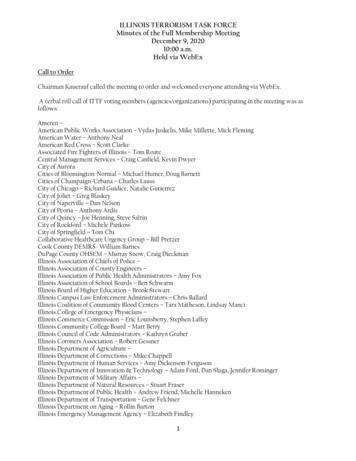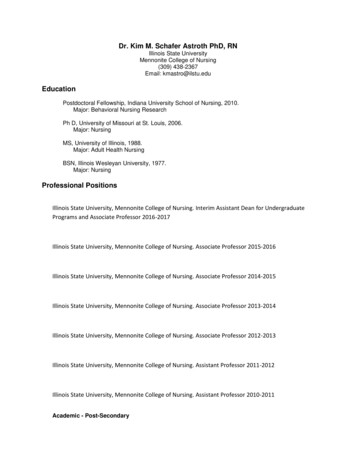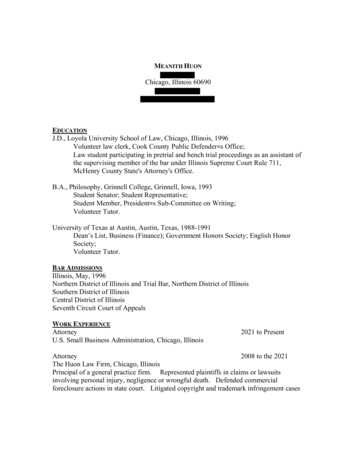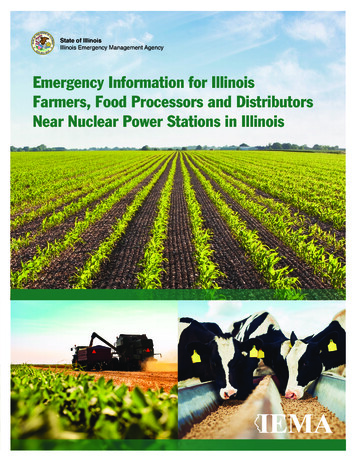
Transcription
1
KEEP THIS BOOKLETThis booklet contains information that will be useful to you in theevent of an accident at any nuclear power station in IllinoisTHE PURPOSE OF THIS BOOKLETThis booklet provides emergency information for the agricultural community within a 50-mile radius of thenuclear power stations in Illinois (Braidwood, Dresden, LaSalle, Byron, Clinton and Quad Cities nuclearpower stations). It contains information concerning how you will be notified and what procedures you shouldfollow in the unlikely event of a radiological emergency at any of these nuclear power stations.If an emergency results in a release of radioactive material to the environment, you may be advised to takeactions to protect your family, farm animals and agricultural products. This information, along with specificinstructions you will receive over the local emergency broadcast radio stations or through other official newsreleases, will help you to prevent or minimize the potential effects of a radiological release on food andagriculture.The instructions in this booklet may also be used in response to other kinds of radiological emergencies.General information on radiation and post-emergency activities is also provided.Please read this booklet thoroughlyTABLE OF CONTENTSEmergency Planning Zones . . . . . . . . . . . . . . . . . . . . . . . . . . . . . . . . . . . . . . . . . . . .3Sources of Emergency Information . . . . . . . . . . . . . . . . . . . . . . . . . . . . . . . . . . . . . .3Braidwood, Dresden and LaSalle Stations . . . . . . . . . . . . . . . . . . . . . . . . . . . . . . . . 4Byron Station . . . . . . . . . . . . . . . . . . . . . . . . . . . . . . . . . . . . . . . . . . . . . . . . . . . . . . .5Clinton Station . . . . . . . . . . . . . . . . . . . . . . . . . . . . . . . . . . . . . . . . . . . . . . . . . . . . . .6Quad Cities Station . . . . . . . . . . . . . . . . . . . . . . . . . . . . . . . . . . . . . . . . . . . . . . . . . . 7Protective Actions for the Food Supply . . . . . . . . . . . . . . . . . . . . . . . . . . . . . . . . . . .8Slaughter Plants, Food Processors and Distributors . . . . . . . . . . . . . . . . . . . . . . . . . 10Post-emergency Actions . . . . . . . . . . . . . . . . . . . . . . . . . . . . . . . . . . . . . . . . . . . . . . 10General Information on Radiation . . . . . . . . . . . . . . . . . . . . . . . . . . . . . . . . . . . . . . .10Summary of Effects on Radioactive Deposits on HumanFood and Water Supplies . . . . . . . . . . . . . . . . . . . . . . . . . . . . . . . . . . . . . . . .11Additional Information . . . . . . . . . . . . . . . . . . . . . . . . . . . . . . . . . . . . . . . . . . . . . . . 11Illinois Emergency Management AgencyPublished December 20212
EMERGENCY PLANNING ZONESTwo types of emergency planning zones (EPZs) may be referred to in an emergency:The Plume Exposure Pathway EPZ is the area within an approximate 10-mile radius aroundthe nuclear power station in which people may be directly exposed to radiation.The Ingestion Exposure Pathway EPZ is the area within an approximate 50-mile radiusaround the nuclear power station in which people may be indirectly exposed to radiation byeating or drinking contaminated food, milk and water.SOURCES OF EMERGENCY INFORMATIONIn the event of an emergency at Braidwood, Byron, Clinton, Dresden, LaSalle or Quad Cities nuclear powerstations, specific protective action recommendations will be issued by appropriate state or local governmentofficials. Information to prevent or minimize radiation contamination of food products will be provided to youthrough at least one of the sources listed below: Local emergency broadcast radio stations will provide you with official emergency information. Thesestations will also provide additional accident-related information. The radio stations designated for eachnuclear power station are listed below the maps on pages 4-7 of this booklet. Your local Cooperative Extension Service Office may provide you with information on the protection ofagricultural products through local radio or television broadcasts, newspaper articles or by telephone. National Oceanic and Atmospheric Administration (NOAA) weather radio broadcasts over tone alertradios will provide you with up-to-date weather information. The broadcasts may also provide you withemergency instructions on protective measures. Additional emergency agricultural information may be available to you through state or local governmentemergency organizations.3
BRAIDWOOD, DRESDEN and LASALLE STATIONS10-MILE PLUME and 50-MILE INGESTION PATHWAY EPZsDESIGNATED RADIO STATIONS FOR BRAIDWOOD, DRESDENand LASALLE STATIONS ARE:Grundy CountyWill CountyKankakee CountyWJDK 95.7 FMWJOL 1340 AMWVLI 92.7 FMWCSJ 103.1 FMWSSR 96.7 FMWIVR 101.7 FMWCCQ 98.3 FMWFAV 95.1FMWRXQ 100.7 FMWYUR 103.7 FMKendall CountyWSPY 107.1 FM4LaSalle CountyWCMY 1430 AMWRKX 95.3 FM
BYRON STATION10-MILE PLUME and 50-MILE INGESTION PATHWAY EPZsDESIGNATED RADIO STATIONS FOR BYRON STATION ARE:WRHL 1060 AMWYOT 102.3 FM5
CLINTON STATION10-MILE PLUME and 50-MILE INGESTION PATHWAY EPZsDESIGNATED RADIO STATIONS FOR CLINTON STATION ARE:WBNQ 101.5 FMWJBC 1230 AMWBWN 104.1 FMWHOW 1520 AMWEZC 95.9 FMWHOW 92.3 FM6
QUAD CITIES STATION10-MILE PLUME and 50-MILE INGESTION PATHWAY EPZsDESIGNATED RADIO STATIONS FOR QUAD CITIES STATION ARE:Rock Island CountyWVIK 90.3 FMWhiteside CountyKCLN 1390 AMKMCN FM 94.77
PROTECTIVE ACTIONS FOR THE FOOD SUPPLYThe safety of the food supply within the 50-mile ingestion exposure pathway EPZ could be a concern tomembers of the agricultural community in the event of a radiological release. During such a release, bothwater and land could become contaminated. Eating contaminated foods and drinking contaminated milk andwater could have a harmful, long-term effect on your health.State and local government emergency response organizations are prepared to quickly notify and advisethe agricultural community on what actions to take in the event of a radiological emergency. The decisionto recommend protective actions will be based on the emergency conditions at the nuclear power station,available information on the amount and type of radiation that has been released to the environment andconsideration of the health, economic, and social impacts of the proposed actions.There are several types of protective actions that will help prevent or lessen the possibility of persons eatingor drinking contaminated food or water: Simple precautionary actions to avoid or reduce the potential for contamination of food and animal feeds.An example would be removing animals from pasture and providing them with stored feed and protectedwater. Actions to isolate or contain food and prevent its introduction into commerce. An example would be torestrict or withhold (embargo) the shipment of agricultural and dairy products from the affected areas toprocessors or the marketplace. Normal food production and processing actions that reduce any contamination that is present. Exampleswould include washing, peeling or shelling products to eliminate surface contamination, and freezing,drying or storing processed products to allow for decay of radioactivity.The following are more specific examples of protective actions and related information that may berecommended to the agricultural community by appropriate state or local government officials. Locationspecific recommendations will be issued by these officials in the event of an actual emergency.MilkRemove all dairy animals from pasture, shelter if possible, and provide them with stored feed and protectedwater. State or local government officials may come to your farm to take milk, feed and water samples forlaboratory analysis to determine whether any of these products are contaminated.If dairy products are found to be contaminated, it may be recommended that milk and milk products bewithheld from the market. It is possible, however, for milk products contaminated with certain radioactivematerials to be safe for human consumption after proper storage over a period of time. This will allow fordecay of the radioactive materials. The decay may be achieved by freezing and storing fresh milk,concentrated milk or concentrated milk products. Storage of milk for prolonged periods of time at reducedtemperature is also possible provided ultra-high temperature pasteurization techniques are used duringprocessing. Using fluid milk for the production of butter, cheese, dry milk or evaporated milk may also bepossible.You will be advised by state or local government officials as to what protective actions are appropriate.8
Fruits and VegetablesWash, scrub, peel or shell locally grown fruits and vegetables, including roots and tubers, to remove surfacecontamination.If they are contaminated by short-lived radionuclides (e.g., Iodine 131), preserve by canning, freezing ordehydration and store to allow time for decay of the radioactivity.Meat and Meat ProductsIf there is a release of radioactive material to the environment, you may be advised to place meat animals onprotected feed and water and, if possible, provide them with shelter. If livestock consume feed and watercontaminated with radioactive materials, some of the contamination will be absorbed into their bodies andcould then enter the human food supply through meat and meat products. If contamination is verified, state orlocal government officials may advise that meat and meat products should not be eaten.Poultry and Poultry ProductsPoultry raised outdoors, especially those kept for egg production, should be monitored by taking samples andperforming laboratory tests to determine the presence of radioactive contamination. Poultry raised indoors andgiven protected feed and water are not likely to be contaminated. If contamination is verified, state or localgovernment officials may advise that poultry and eggs should not be eaten.Fish and Marine LifeFish and other marine life raised in ponds may continue to be harvested unless appropriate state or localgovernment officials have determined through laboratory analysis of samples that they are contaminated.Samples of water, fish and marine life from open bodies of freshwater should also be analyzed to ensure thatthey are safe.SoilsIf state or local government officials find that the soil is contaminated, proper soil management procedures canbe implemented to reduce contamination to safe levels. Idling (the nonuse of the land for a specific period oftime) may be necessary in some cases. However, in situations involving highly contaminated soil, removal anddisposal of the soil may be more appropriate.Planting alternative crops may also be recommended in some situations. Crops such as cotton and flax couldbe substituted for food crops because they contribute little or no radioactive material to the human diet.Deep-plowing the soil will move radioactive substances below the plant root level, prevent plants from takingup contaminated nutrients and allow the level of radioactivity to decrease with the passage of time.State or local government officials will let you know what actions are appropriate.GrainsIf grains are permitted to grow to maturity, it is plausible that most contamination will be removed by thewind and rain. Screening or cleaning should remove any remaining contamination. Sampling and laboratoryanalysis will determine if the grain is safe to use. When harvested, contaminated and uncontaminated grainsshould be stored separately.WaterIt is improbable that covered wells and other covered or underground sources of water will becomecontaminated. Radiation contaminants deposited on the ground will travel very slowly through the soil unlesssoils are sandy. It is unlikely that underground water supplies will be affected.9
Water from cisterns and surface sources such as lakes and ponds should not be used.Close water intake valves from any contaminated water sources to prevent distribution (e.g., irrigation) ofcontaminated water. Stored water that is exposed to the open air (such as livestock watering troughs) shouldbe discarded and not reused.HoneyHoney and bee hives will need to be sampled and analyzed by appropriate state or local government officials ifradioactive contamination is detected in the area. You will be instructed by these officials on how to handle thehives and honey.SLAUGHTER FACILITIES, FOOD PROCESSORS AND DISTRIBUTORSRadioactive contamination of milk or food products in an affected area can occur during processing or duringtransportation. This can result from exposure to radioactive materials on the ground, in the air and fromcontact with contaminated products.Following a radiological emergency, government officials may restrict the movement of food products andwithhold them from the marketplace if they are found to be contaminated. These products should not bereleased until they are considered to be safe for consumption or until a decision is made to dispose of them.You will be instructed how to safely handle and dispose of contaminated food products.POST-EMERGENCY ACTIONSThe following sections describe post-emergency actions that will occur if contamination is verified.Re-entry is the temporary entry, under controlled conditions, into a restricted, contaminated area, in allprobability within the 10-mile radius of the nuclear power station. If you have been evacuated from your area,you may be allowed to return temporarily to your farm when conditions permit. State or local governmentofficials will advise you through the local news media if a decision to permit re-entry is made. You willreceive specific instructions on routes to use and safety precautions to take. Re-entry will allow you to performsuch vital activities as milking, watering and feeding farm animals.Recovery is the process of reducing radiation in the environment to acceptable levels for normal dailyliving. Following the emergency, state and local government officials will identify the types and levels ofcontamination. They may need to take samples of air, water, soil, crops and animal products from your farmor business. They will provide you with instructions and assist you in decontaminating your animals, foodand property if such actions are necessary. Contaminated food will be isolated to prevent its introduction intothe marketplace. State and local government officials will determine whether condemnation and disposal areappropriate.GENERAL INFORMATION ON RADIATIONRadiation and radioactive materials are a natural part of our environment. They are in the air we breathe, in thefood we eat, in the soil, in our homes and even in our bodies. The level of radiation naturally existing in ourenvironment is called “background radiation.” It may vary greatly from one location to another depending onrelated factors such as solar radiation, geographic elevation, soil composition and the presence of radon gasesfrom the soil and building materials. We also are exposed to sources of man-made radiation such as X-raymachines and smoke detectors. Commercial nuclear power stations may release small, non-harmful amountsof radioactive materials to the environment under controlled conditions and during routine operations.10
Radiation dose to individuals that results from radiation exposure is measured in units of millirem. In theUnited States, the average background radiation exposure received by each person is about 310 millirems peryear. Each person also receives about 310 millirems a year from medical care sources. An approximate 12millirems is received from consumer products (including exposure from tobacco use) and occupational andother environmental sources. The total average exposure per person per year is about 620 millirems. Personsliving near a commercial nuclear power station receive less than one additional millirem per year.The effects of radiation on people depend on the amount and length of time of exposure, how much of thebody is exposed, how much radioactive material stays in the body, and the general health and age of theexposed person. The effects of radiation can be decreased by reducing the amount of time the person isexposed, placing shielding between the source and the person and increasing the distance from the source ofradiation. In general, a yearly dose of 620 millirem from all radiation sources has not been shown to causehumans any harm.SUMMARY OF EFFECTS OF RADIOACTIVE DEPOSITS ON HUMAN FOOD AND WATER SUPPLIESDepending on the amount of radioactive materials released into the atmosphere and the prevailing weatherconditions, people, animals, crops, land and water near the site of the emergency could be affected. Theinitial concern would be the condition of fresh milk from dairy animals grazing on pasture and drinkingfrom open sources of water. Sampling for contamination could occur at the farm, the transfer station orthe processing plant. If contamination of fresh milk and processed milk products is verified, state or localgovernment officials will determine whether to dispose of these products or to hold them until safe forconsumption.A later concern would be the possible contamination of vegetables, grains, fruits and nuts. The severityof the contamination’s impact would depend on the time of the year the emergency occurred. The timeapproximately prior to or during harvest is the most critical period. Crops will be sampled and analyzed bythe appropriate government officials to ensure that they are safe to eat.An additional concern would be the possible impact of the contamination on livestock and poultry. Pasture,feed and water sources, as well as meat and poultry products, will be sampled and analyzed to ensure that themeat and poultry products are safe to eat.Contamination of drinking water supplies is not likely to be significant. If it occurs, it will probably affectonly surface water supplies and not ground water wells or underground water sources. The safety of waterwould be determined by sampling public and private sources. If land becomes contaminated, proper soilmanagement techniques can be implemented to reduce contamination of crops grown on the land. Theprocedures recommended would depend on the severity of contamination and the specific crops to be grown.In conclusion, while it is unlikely that a serious radiological emergency will occur in this country, it isimportant to be prepared for such an event. The information in this booklet may help you more effectivelyrespond to such an emergency.ADDITIONAL INFORMATIONIf you would like additional booklets or other information, or have questions concerning radiation, pleasecontact the Illinois Emergency Management Agency, REP Program Manager, (217) 782-7860.Printed by Authority of the State of Illinois 12-21 IOCI 22-0494110 copies
Illinois Emergency Management Agency1035 Outer Park DriveSpringfield, Illinois 627042021/2022 EMERGENCY INFORMATION - KEEP THIS BOOKLET ACCESSIBLE
concentrated milk or concentrated milk products. Storage of milk for prolonged periods of time at reduced temperature is also possible provided ultra-high temperature pasteurization techniques are used during processing. Using fluid milk for the production of butter, cheese, dry milk or evaporated milk may also be possible.
